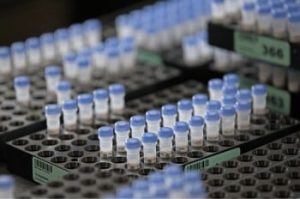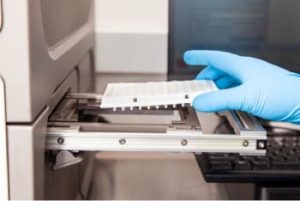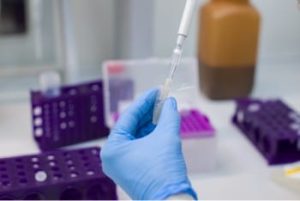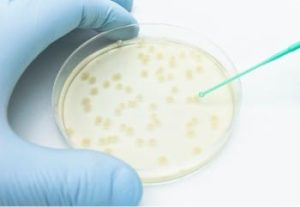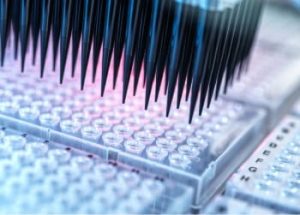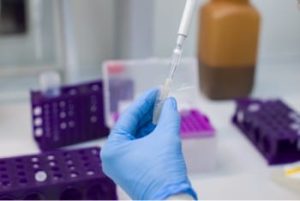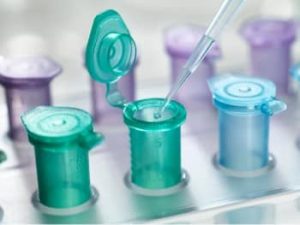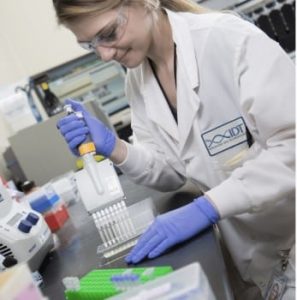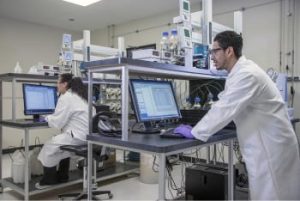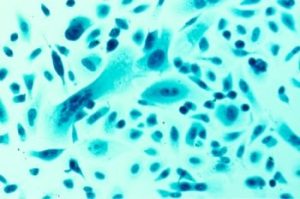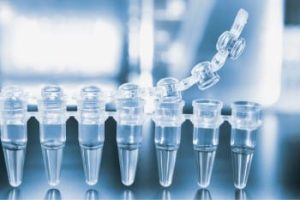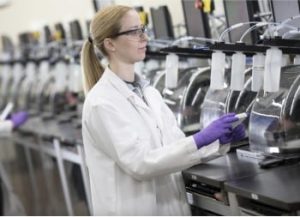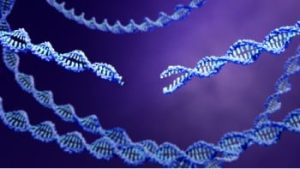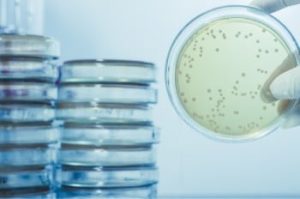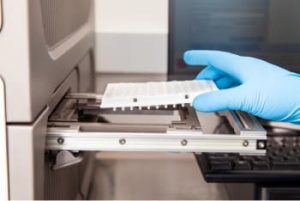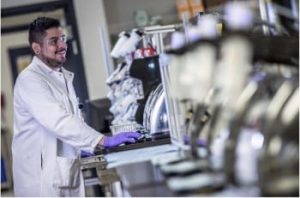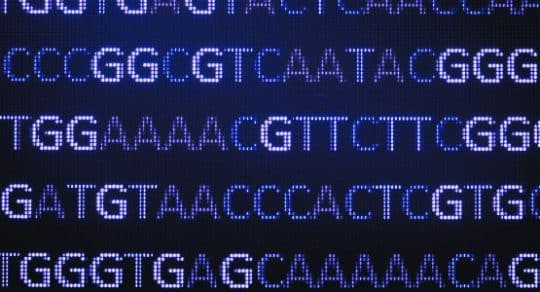After receiving an envelope containing their order of newly synthesized IDT oligonucleotides, many researchers find themselves asking the question, “Now what should I do with these oligos?” At this point, several important decisions must be made regarding oligonucleotide resuspension, dilution, and storage, which may vary depending on the intended application for each oligo. Here, we provide recommendations for preparing oligos to use in experiments and guidelines for proper storage.
Oligo resuspension
Centrifugation and resuspension. Most oligonucleotides synthesized and shipped from IDT are delivered dried down and often appear as a white flakey substance in the bottom of the tube. Dried DNA is quite stable and, typically, is easy to resuspend in an aqueous solution. The first step a researcher should take upon receipt of their oligos is to briefly centrifuge the tubes before opening them [1]. This helps to ensure that any dried DNA that may have become dislodged during shipping is brought down to the bottom of the tube. Next, the oligos should be resuspended in TE buffer (IDTE: 10 mM Tris, 0.1 mM EDTA, pH 8.0). Tris (tris(hydroxymethyl)aminomethane) acts as a buffer, helping to maintain a constant pH for the solution. EDTA (ethylenediaminetetraacetic acid) prevents nuclease digestion of the DNA [2]. At higher concentrations, EDTA can inhibit enzymatic reactions, such as PCR, by chelating metals ions like Mg2+ [3]. However, the low concentration of EDTA present in IDTE buffer will not interfere with subsequent enzymatic reactions. TE buffer can be made with common lab reagents or is conveniently available for purchase from IDT's selection of buffers and solutions.
Alternatively, nuclease-free water, pH 7.0, can be used for resuspending oligonucleotides, but it will not modulate pH over time as will TE buffer. Use of HPLC- or molecular biology-grade water is preferable, as water from a deionizing system (such as Millipore) can be acidic, with a pH as low as 5.0. Water treated with DEPC (diethylpyrocarbonate) is not recommended for resuspension of DNA oligonucleotides because it can degrade the DNA during long-term storage.
Concentration and dilution. Investigators commonly call in for advice regarding the concentration at which their oligos should be resuspended. This is largely up to the discretion of the researcher and is dependent on how the oligo will be used in future experiments. Oligonucleotides are stable when stored over a large range of concentrations; however, we recommend concentrations no less than 1 µM and no greater than 10 mM (100 µM is a convenient concentration). IDT offers a Resuspension Calculator as part of our SciTools™ suite, which is useful for calculating the volume of buffer to add to a dried down oligo to obtain a desired concentration. Resuspension calculations can be made using the yield information that is provided both on the oligo tubes themselves and on the IDT oligo product specification sheets provided with the order. For your convenience and utility, this yield information is presented in optical density (OD) units, mass (mg), and nanomoles (nmol).
Our standard recommendation is to resuspend oligos to a 100 µM stock concentration, as this is a simple concentration to make and is highly versatile for subsequent dilution purposes. The volume of TE buffer required to obtain a 100 µM stock is easily determined by multiplying the number of nanomoles listed for a particular oligo by a factor of 10, and then resuspending the dry DNA in that same number of microliters of TE buffer. For example, if the oligo specification sheet states that 20.3 nmol of oligo were delivered, add 203 µL TE buffer to obtain a 100 µM stock solution. This stock solution can be diluted as needed to appropriate working solutions. IDT recommends taking an A260 nm absorbance measurement and calculating the exact concentration using the Beer-Lambert equation.
Resuspension difficulties. While most oligonucleotides will readily go into solution at concentrations <10 µM, some oligos (with certain fluorophore modifications and some hydrophobic modifications, such as cholesterol) can be more difficult to resuspend. For oligos that are harder to resuspend, and for which one might observe residual precipitate present following resuspension, we recommend that the oligo be heated at 55°C for 1–5 minutes, vortexed thoroughly, and then briefly centrifuged. Occasionally, residual by-products of the synthesis reactions remain in the tube and are visible after resuspension. These include trityl (appears flakey) and CPG (controlled porous glass, which forms a pellet at the bottom of the tube). Neither of these reagents should negatively impact the results obtained using the oligonucleotide; however, both can be easily removed by passing the resuspended oligo over a Sephadex G50 column.
Oligo storage
Ideal conditions for standard DNA oligonucleotides. IDT has tested the stability of oligonucleotides following various storage conditions. The results of these studies indicate that the most stable temperature at which to store a standard DNA oligonucleotide is –20°C. An oligo stored at –20°C is stable for at least 24 months when either dried down or resuspended in TE buffer or nuclease-free water. Standard DNA oligos dried down or stored at 5°C in TE buffer or water were found to be stable for long periods; however, better stability is obtained by freezing if the oligos are to be stored for extended periods. Standard DNA oligos stored at 37°C are stable for at least 6 weeks in water or 25 weeks dried down or in TE. Storage at higher temperatures is not recommended. However, accidents can happen, such as oligos being left on the bench top overnight or freezers failing over the weekend, and it is important to understand that the integrity of the oligo should not be affected. Regardless of the storage temperature, resuspension in TE buffer, rather than in water or dried down, is best for long-term storage.
Storing oligos with fluorophores. Typically, fluorophore-labeled oligos show a reduction in signal of about 20% after 24 months when stored at –20°C in TE. For oligos with a fluorophore modification, particularly the Cy® and FAM dyes, researchers may wish to store these oligos in amber tubes or covered in foil to prevent photobleaching, which can occur over time with prolonged exposure to light.
Special considerations for RNA oligonucleotides
The inherent chemical structure of RNA makes it less stable than DNA because the additional hydroxyl group attached to the 2’ position of the pentose ring in RNA nucleotides makes RNA more prone to alkaline hydrolysis. In addition, RNases are pervasive, making RNA more susceptible than DNA to degradation. Thus, RNA oligonucleotides should be stored as an ethanol precipitate at –80°C [4] for greater stability. For short-term storage, we recommend resuspending RNA oligos in a nuclease-free neutral to slightly acidic buffer containing a chelating agent, such as IDTE. However, it is always important to avoid RNases and alkaline hydrolysis when RNA oligos are stored.
For more information about oligo storage, see the article, Storing oligos: 7 things you should know.
References
- Podivinsky E, Love JL, van der Colff L, et al. Effect of storage regime on the stability of DNA used as a calibration standard for real-time polymerase chain reaction. Anal Biochem. 2009;394(1):132-134.
- Nadano D, Yasuda T, Kishi K. Measurement of deoxyribonuclease I activity in human tissues and body fluids by a single radial enzyme-diffusion method. Clin Chem. 1993;39(3):448-452.
- Chen B, Costantino HR, Liu J, et al. Influence of calcium ions on the structure and stability of recombinant human deoxyribonuclease I in the aqueous and lyophilized states. J Pharm Sci. 1999;88(4):477-482.
- Farrell RE. Chapter 2: RNA Isolation Strategies. In: Farrell RE, ed. RNA Methodologies. 4th ed. Academic Press; 2009;45–80.
For research use only. Not for use in diagnostic procedures. Unless otherwise agreed to in writing, IDT does not intend these products to be used in clinical applications and does not warrant their fitness or suitability for any clinical diagnostic use. Purchaser is solely responsible for all decisions regarding the use of these products and any associated regulatory or legal obligations. RUO22-1654_001

